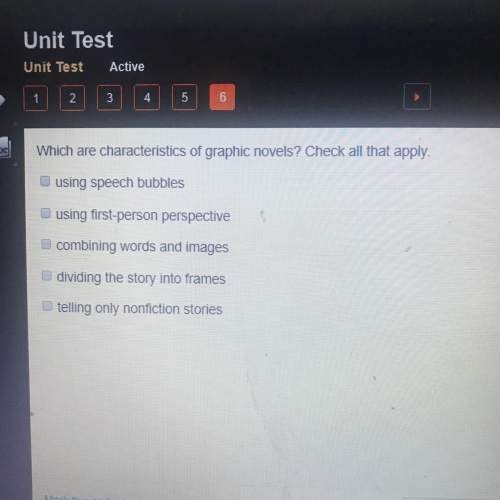The Mystery of Loch Ness
By Kayden Mitchell
Of all the mysteries in the world, none ha...

English, 05.12.2021 02:40 angelteddy033
The Mystery of Loch Ness
By Kayden Mitchell
Of all the mysteries in the world, none has been as popular as that of the Loch Ness Monster. Perhaps the biggest mystery is whether it is convincing evidence or a simple desire to believe that keeps the myth alive.
Loch Ness is a lake in Scotland. The loch, or lake, is known for sightings of a mysterious monster. Most who see this monster, known as Nessie, describe something with a long neck and several humps above the water. Sometimes the "monster" is moving in these sightings, and sometimes it is still. Many have suggested that Nessie might be a plesiosaur (plea-see-a-soar), an aquatic dinosaur that was trapped in the loch after the last ice age.
The plesiosaur theory presents several problems. First, the plesiosaur is an air breather. Such a creature would need to surface often and, therefore, be seen more frequently. Second, it's unlikely that the same creature has lived in the loch since the last ice age. Today's creature would have to be the offspring of an original plesiosaur trapped long ago. This would suggest multiple creatures in the loch (needed to produce offspring). Again, sightings would be more frequent if this were the case.
So from a purely logical stand point, the existence of such a large and ancient creature is unlikely. But assume for a minute that it is possible. What would a plesiosaur need to live in an enclosed lake?
Tropical waters: Scientists believe plesiosaurs were warm-blooded. Like crocodiles and alligators, plesiosaurs would need to live in warm waters. The loch is very cold with temperatures averaging about 40 degrees Fahrenheit (4.4 Celsius).
Food: Like other warm-blooded creatures, plesiosaurs would need a large quantity of food. If there is a group of Nessies, then even more food would be needed. Because the loch is full of silt (underwater dust) not much light gets into the deepest areas. So the food chain, which would depend on plankton, is very weak at its base. As a result, there is probably not enough food to support such a large creature.
However, the plesiosaur theory is not the only one. Many other ideas attempt to explain the sightings and "photographs." But two separate sonar surveys of the loch have not found any evidence of a creature larger than a salmon. The last survey,1 completed in 2007 by the British Broadcasting Company (BBC), involved 600 different sonar beams. Using satellite navigation systems, the team made sure every inch of the loch was searched. The team found nothing.
With cell phones and digital cameras, one would think that sightings of Nessie would increase. This has not happened. The BBC team believes the legend of Nessie has endured because people see what they want to see. To prove this, the team used a fence post, raising it before groups of tourists. Afterwards several of the tourists asked to draw pictures of what they had seen drew pictures of a monster's head.
Based on the text, what is the main result of scientists having studied the plesiosaur?
A. The people who claim to have seen Nessie can be proven to have been dishonest.
B. The sightings have decreased rapidly since the studies were released.
C. We can conclusively rule out the existence of modern plesiosaurs.
D. We know enough to rule out a plesiosaur as a likely Nessie creature.

Answers: 3
Another question on English

English, 21.06.2019 17:30
The speaker in the “to a mouse” regrets that the mouse runs away so fast because the
Answers: 3

English, 22.06.2019 02:30
Plz ! i genetic mutation occurs in a rabbits muscle cell this genetic mutation will be passed on to, a. the existing cells in the rabbits body. b. the cells that are next to the mutant muscle cell. c. cells that are produced when the mutant cell divides. d. the cells of the rabbits offspring.
Answers: 2

English, 22.06.2019 06:00
3one of the biggest impacts a building has on earth is the energy it uses. currently, most of the world’s energy comes from burning fossil fuels. these fuels are dirty and when they are burned they pollute the air and water. one way to burn fewer fossil fuels is to reduce the amount of electricity a building has to use. passive solar heating, which uses heat from the sun, reduces the amount of fossil fuel used to heat buildings. passive solar heating requires a south-facing wall made of glass. when sunlight shines through the wall, it is collected and used to warm the building. another way green buildings reduce their electricity use is to install other energy sources. for example, some green buildings use panels that turn energy from the sun into useable electricity. which is the best summary of paragraph 3? a) fossil fuels are dirty and pollute the air and water. most of the world's energy comes from these fuels. b) the biggest problem of buildings is that they use fuel that is dirty for heating. they need to do something to be more energy efficient. c) panels that turn energy from the sun into electricity and passive solar heating can stop the burning of fossil fuels which pollute air and water. d) since fossil fuels are dirty and pollute the air and water, other technologies that pollute less and produce energy have been developed like solar energy and green buildings.
Answers: 2

English, 22.06.2019 06:10
Which type of context clue does the author use to show the meaning of the word diplomats?
Answers: 2
You know the right answer?
Questions



Mathematics, 12.05.2021 01:50




Mathematics, 12.05.2021 01:50


Mathematics, 12.05.2021 01:50

Mathematics, 12.05.2021 01:50

Biology, 12.05.2021 01:50

Mathematics, 12.05.2021 01:50


Mathematics, 12.05.2021 01:50

Mathematics, 12.05.2021 01:50

Computers and Technology, 12.05.2021 01:50

Chemistry, 12.05.2021 01:50

Mathematics, 12.05.2021 01:50


Law, 12.05.2021 01:50




